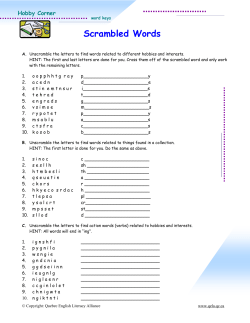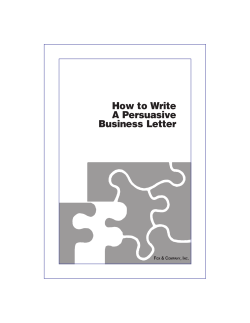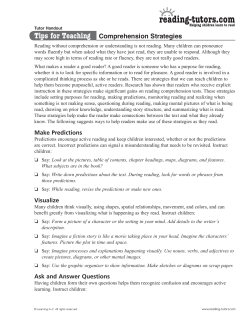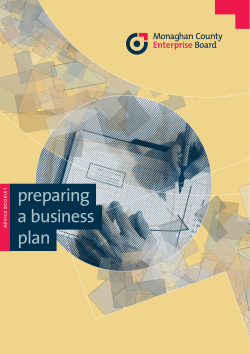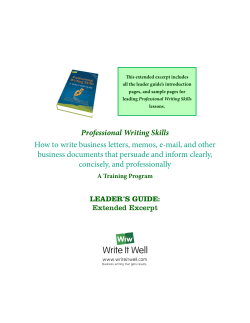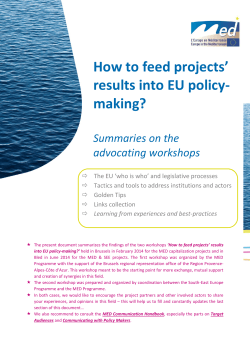
clearly How to write EN 1
European Commission How to write clearly EN 1 e How to writ clearly European Commission staff have to write many different types of documents. Whatever the type — legislation, a technical report, minutes, a press release or speech — a clear document will be more effective, and more easily and quickly understood. This guide will help you to write clearly whether you are using your own language or one of the other official languages, all of which are also working languages of the Commission according to Council Regulation No 1/1958 (still valid today!) These are hints, not rules, and when applying them you should take account of your target readers and the purpose of your document. Three good reasons to write clearly are: • to work more effectively together • to reduce unnecessary correspondence • to build goodwill. Hint 1: Think before you write............................................................................................................................. page 3 Hint 2: Focus on the reader — be direct and interesting.............................................................................. page 4 Hint 3: Get your document into shape............................................................................................................. page 5 Hint 4: KISS: Keep It Short and Simple................................................................................................................ page 6 Hint 5: Make sense — structure your sentences.............................................................................................. page 7 Hint 6: Cut out excess nouns – verb forms are livelier................................................................................... page 8 Hint 7: Be concrete, not abstract........................................................................................................................ page 9 Hint 8: Prefer active verbs to passive — and name the agent................................................................page 10 Hint 9: Beware of false friends, jargon and abbreviations.....................................................................page 11 Hint 10: Revise and check....................................................................................................................................page 14 Online EU drafting aids.......................................................................................................................................page 15 2 1. Think before you write Clear writing starts with and depends on clear thinking. Ask yourself: Who will be reading the document? Three main groups of people read European Commission documents: • EU insiders — colleagues in the European Commission or other institutions • outside specialists • the general public — which is by far the largest group. Most European Commission documents are now on the internet and available to everyone. Everything we write and publish as part of our work for the European Commission inevitably affects the public image of the EU. See Hint 2 for tips on reader focus. What are you trying to achieve? What is the purpose of your document? After reading it, what will your readers have to do? • • • • make a decision? handle a certain situation? solve a particular problem? change their attitude towards something? ns viatio abbre What points must the document cover? • Decide on your message • Make a list or bubble diagram (see illustration) containing all the points you expect to make, in no particular order. • Cross out the irrelevant points. • Link the remaining points into related groups. • Fill any gaps in your knowledge: make a note of facts you will need to check and/or experts you will need to consult. This approach applies to practically all non-literary texts: memos, reports, letters, user guides, etc. For formal documents such as legislation, specific drafting rules must be followed. An alternative is the ‘7 questions’ approach. This is a structured method of covering relevant information: WHAT? My essential message WHO? Persons concerned WHEN? Days, hours, timelines, deadlines WHERE? Places HOW? Circumstances, explanations WHY? Causes and/or objective HOW MUCH? Calculable and measurable data long jargon passiv e ct abstra 3 2. Focus on the reader Be direct and interesting Always consider the people you’re really writing for: not just your boss, or the reviser of your translations, but the end users. Like you, they’re in a hurry. Who are they, what do they already know, and what might you need to explain? Try to see your subject from the point of view of your readers: —Involve them by addressing them directly (‘you’ is an under-used word in European Commission documents). —Imagine which questions they might ask, and make sure the document answers them. Maybe even use these questions as sub-headings. For example: ‘What changes will this new policy make?’ ‘Why is this policy needed?’‘Who will be affected?’ ‘What do we expect to achieve?’. —Interest them. Give them only the information they actually need. Leave out as many details of European Commission procedures and interinstitutional formalities as you can. These are meaningless to most readers and simply reinforce the Commission’s image as a bureaucratic and distant institution. If they are really essential, briefly say why. Now you can make your outline. 4 3. Get your document into shape When you start As you write • If your outline includes a summary, begin with that: you may find it is enough! Put it at the beginning because that is the first (and sometimes the only) part that people will read. • Follow our hints below • Pay particular attention to links that will help readers to follow your logic and reasoning. Choose headings and other ‘signposts’ that will enable them to find key information to save you repeating it throughout the document. Use informative headings and sub-headings to highlight the most important points of the document. A heading such as ‘Mergers need to be monitored more carefully’ is more informative than ‘Monitoring mergers’. • Consider how best to make your points and keep your document reader-friendly: could you use icons, graphs, or tables instead of text? Do you need a glossary or a list of definitions? • After the beginning, the next most frequently read part is the conclusion. A reader may skip everything in between to get to the conclusion. Make it clear, concise and to the point. • Consult EU drafting aids (see last page) Keep cutting! Be tough – ask if each section and each word is really necessary. Cut out superfluous words, but make sure the message is still clear: • The deadline to be observed for the submission of applications is 31 March 2010. The deadline for submitting applications is 31 March 2010 Application deadline: 31 March 2010 After you’ve finished See Hint 10 for advice on revising and checking. • Show your readers the structure of longer documents by including a clear table of contents. Two common problems at the European Commission: 1. Recycling an earlier text without adapting it properly Older models may be unclearly written and may not reflect new circumstances and new drafting practices. Take care to make all the necessary adaptations. 2. Cutting and pasting You may have to use passages from a variety of documents to assemble a new text. Beware of inconsistent terminology, repetition or omission: these can undermine the internal logic and clarity of the end result. 5 4. KISS: Keep It Short and Simple Short ... ... and Simple: The value of a document does not increase the longer it gets. Your readers will not respect you more because you have written 20 pages instead of 10, especially when they realise that you could have written what you wanted to say in 10. They may well resent you for taking more of their time than necessary. Use simple words where possible. Simple language will not make you seem less learned or elegant: it will make you more credible. Some ways to cut out unnecessary words include: • Not stating the obvious. Trust your readers’ common sense. in view of the fact that as a certain number of some the majority of most pursuant to under within the framework of under accordingly, consequently so for the purpose of to in the event of if if this is not the case if not if this is the case if so concerning, regarding, relating to on with reference to, with regard to about • Not cluttering your document with redundant expressions like ‘as is well known’, ‘it is generally accepted that’, ‘in my personal opinion’, ‘and so on and so forth’, ‘both from the point of view of A and from the point of view of B’. • Not repeating yourself. When referring to, say, a committee with a long name, write out the full name once only: ‘This question was put to the Committee on the Procurement of Language Style Guides. The Committee said that ...’. Shorter documents and shorter sentences tend to have more impact. As a guide: 1 document = 15 pages at the most 1 sentence = 20 words on average (but sprinkle in a few short sentences!) Unnecessarily long sentences are a serious obstacle to clarity in European Commission documents. Try to break them up into shorter sentences. But remember to include link words (‘but’, ‘so’, ‘however’) so the coherence doesn’t get lost in the process. 6 Simple, uncluttered style also means: You must hand in your application by Tuesday. The committee may turn down your request... (i.e. your application — or is it?). ... avoiding ambiguity If you use the same word to refer to different things, you could confuse your reader: You must hand in your application by Tuesday. You may also submit an application for this deadline to be postponed. Your application ... (what are we talking about now?) You must hand in your application by Tuesday. The committee may turn it down ... ... using the positive form, not the negative You must hand in your application by Tuesday. You may also ask for the deadline to be postponed. Your application ... ... not changing words just for ‘style’ You may think you can make your document less boring by using different words to refer to the same thing. Again, though, you could confuse your reader: 5. It is not uncommon for applications to be rejected, so do not complain unless you are sure you have not completed yours incorrectly. It is quite common for applications to be rejected, so complain only if you are sure you have completed yours correctly. Make sense — structure your sentences You may have to write (or improve) a text containing a mass of facts and ideas. Here are some ways of untangling the information so that readers will understand each sentence straight away. Name the agents of each action (see Hint 8) and put the actions in the order in which they occur. The Commission outlined several proposals for reducing roaming charges. The smoking in restaurants ban now seems likely to be implemented. When all applicants have submitted their project applications, 1 the Award Committee will meet 2 to decide 3 how much EU aid it will grant to each one. 4 As for reducing roaming charges, the Commission outlined several proposals. Its decision on allocation of EU assistance will be taken subsequent to receipt of all project applications at the Award Committee’s meeting. Don’t bury important information in the middle of the sentence. Smoking in restaurants is now likely to be banned. Try to give your sentences strong endings — that’s the bit readers will remember. Complete institutional reform is advocated by the report in most cases. In most cases, the report advocates complete institutional reform. 7 6. Cut out excess nouns — verb forms are livelier One simple way to write more clearly is to change ... There are other nouns that don’t end in ‘-ion’ but which are also verbs in disguise: this… ... to this: by the destruction of by destroying conduct a review of review for the maximisation of for maximising perform an assessment of assess of the introduction of of introducing effect a renewal of renew By making this change, we are simply turning a noun back into a verb. Verbs are more direct and less abstract than nouns. Many nouns ending in ‘-ion’ are simply verbs in disguise. They often occur in phrases like those below, where verbs would be clearer: carry out an evaluation of evaluate hold an investigation of investigate give consideration to consider 8 So we can make a document clearer by turning some nouns back into verbs: The practice of growing perennials instead of annual crops can bring about an improvement of soil quality by effecting an increase in soil cover. Growing perennials instead of annual crops can improve soil quality by increasing soil cover. 7. Be concrete, not abstract Concrete messages are clear — abstract language can be vague and off-putting. Too much abstract language might even lead your reader to think either that you don’t know what you are writing about or that your motives for writing are suspect. Unless you have a good reason, if you can use a concrete word instead of a more abstract word that means the same, choose the concrete word. Your message will be more direct and therefore more powerful. Sometimes, instead of this ...: you could try this: eliminate cut out achieve an objective meet a target employment opportunities jobs negative evolution downturn remunerated employment paid work investing in human capital * - (workforce) training - improving (workers’) skills - training and education TIP: In Word, highlight and right-click on a word and select ‘Synonyms’, near the bottom of the menu that appears, to find the word you are really looking for. The list of synonyms will contain both abstract and concrete words. Try to choose a concrete word instead of a vaguer all-purpose one. For example, the word identify is perfectly acceptable, but sometimes a clearer word is better: to identify innovations to spot innovations to identify the participants to name the participants to identify the meaning to see / show / pinpoint the meaning * As this example shows, the problem is often pinning down your exact meaning. 9 8. Prefer active verbs to passive... Another easy step to clear writing is to use verbs in the active voice (‘the car hit a tree’) rather than the passive (‘a tree was hit by the car’). Compare these: New guidelines have been laid down by the President in the hope that the length of documents submitted by DGs will be restricted to 15 pages. … and name the agent If you change passive verb forms into active ones, your writing will become clearer because you will be forced to name the agent — the person, organisation or thing that is carrying out the action. It’s easy to identify the agent here ... The President has laid down new guidelines in the hope that DGs will restrict the length of documents to 15 pages. This project was rejected at Commission level. Look how we can make a sentence clearer by cutting out passives...: unclear: A recommendation was made by the European Parliament that consideration be given by the Member States to a simplification of the procedure. a bit better: The European Parliament made a recommendation that the Member States give consideration to a simplification of the procedure. and finally by using verbs instead of abstract nouns: 10 much better: The European Parliament recommended that the Member States consider simplifying the procedure. The Commission rejected this project. ... but impossible here: It is considered that tobacco advertising should be banned in the EU. Who considers? The writer, the Commission, the public, the medical profession? Remember that EU documents have to be translated into several languages. If your original document is unclear, you may end up with non-matching translations, as each translator tries to guess what you might have meant and comes up with a different solution. But you don’t have to avoid passives at all costs. They can be useful, for example when there’s no need to say who is responsible for the action because it’s obvious (‘All staff are encouraged to write clearly’). 9. Beware of false friends, jargon and abbreviations Avoid false friends False friends (or faux amis) are pairs of words in two languages that look similar, but differ in meaning. In a multilingual environment like the European Commission, we often mix up our languages. Borrowing between French and English is common. For instance, ‘to control’ in English normally means ‘to command/ direct’ or ‘to restrict/limit’. It does not mean simply ‘to check/supervise’ like ‘contrôler’ in French. Using the wrong word can alienate readers, making the EU institutions look like a closed club that is out of touch with the real world. In the worst case, it can lead to misunderstandings and diplomatic incidents (for example, if you just want to say that Luxembourg is small, but you write that ‘Luxembourg is not an important country’). French False friend Why is it wrong? What’s the correct word? actuel actual ‘actual’ means ‘real’ current, topical adéquat adequate ‘adequate’ means ‘sufficient’ suitable assister à assist at ‘assist’ means ‘help’. attend, participate in attribuer attribute to ‘attribute to’ means ‘consider to be due to/characteristic of’ allocate to, assign to compléter complete ‘complete’ means ‘finish’ supplement délai delay ‘a delay ’ means ‘a postponement or hold-up’(= retard in French) deadline, time limit élaborer elaborate (verb) ‘to elaborate’ means ‘to go into detail’ draft, develop, produce éventuel eventual ‘eventual’ means ‘ultimate’ any prévu foreseen ‘foreseen’ means ‘predicted’ provided for, planned important important ‘important’ is right if you mean ‘significant’; but not if you mean> > large matériel material ‘material’ means ‘matter’, ‘information’ supplies, equipment opportunité opportunity ‘opportunity’ means ‘chance’ advisability perspectives perspectives ‘perspective’ means ‘standpoint’ prospects, outlook respecter respect ‘to respect’ means ‘to value’ or ‘honour’ someone or something comply with (rules), meet (a deadline) sensible sensible ‘sensible’ means ‘reasonable’ sensitive 11 Avoid or explain jargon Jargon is vocabulary used by any group of insiders or specialists to communicate with each other, and is acceptable in documents which are only read by that group. However, outsiders (especially the general public) will have to work harder than they need to or want to when reading jargon. Some readers may even stop reading — so make sure that any document you want outsiders to read is as jargon-free as possible. And if you DO have to use jargon terms in documents for the general public, explain them when you first use them, or add a glossary, a hyperlink or a reference to one of the websites indicated at the bottom of this page. This non-exhaustive table contains a number of terms commonly used in the EU institutions: Jargon term Suggested definition acceding country country about to join the EU acquis (communautaire) body of EU law candidate country country still negotiating to join the EU cohesion approach aimed at reducing social and economic disparities within the EU comitology procedure under which the Commission consults committees of experts Community method method developed for taking decisions in the EU, where the Commission, Parliament and Council work together enlargement expansion of the EU to include new members mainstreaming taking into account in all EU policies proportionality principle that a level of government must not take any action that exceeds that necessary to carry out its assigned tasks subsidiarity principle that, wherever possible, decisions must be taken at the level of government closest to citizens Clear explanations of much jargon can be found in: the ‘Plain Language Guide to Eurojargon’ section on the Europa website (http://europa.eu/abc/eurojargon/index_en.htm). For definitions of more technical and legal terms arising in an EU context, see the online Europa Glossary (http://europa.eu/scadplus/glossary/index_en.htm). 12 Take care with abbreviations Too many unfamiliar abbreviations can make a document incomprehensible and send your reader to sleep: (ERDF + EAGGF + CAP = ZZZ). If the meaning of an abbreviation might not be clear to your reader, you should: • write them out in full if the expression only occurs once or twice in the document; or • spell them out when you first use them in a document, followed by the abbreviation in brackets, and then use the abbreviation in the rest of the document; and/or • attach a list of abbreviations or a hyperlink to show what they stand for. The ‘Main Acronyms and Abbreviations’ section of the Interinstitutional Style Guide (http://publications. europa.eu/code/en/en-5000400.htm) defines many of the acronyms and abbreviations used in European Commission documents. As always, consider your readers’ needs: • Some readers will be irritated if ‘common’ abbreviations are spelled out. • Writing ‘marketing authorisation holder’ on every other line instead of ‘MAH’ will make the document much longer. Remember that abbreviations and acronyms can mean different things in different contexts. For example: ESA stands for European Space Agency Euratom Supply Agency European System of Accounts Endangered Species Act Environmentally Sensitive Area Eastern and Southern Africa Electron Stimulated Adsorption and several other alternatives. Source: http://iate.europa.eu ESA ESA ESA ESA ESA ESA ESA ESA 13 10. Revise and cheque check • Use spelling and grammar checkers, but be aware that they don’t pick up all mistakes. Need more help? • Re-read your document critically, putting yourself in the reader’s shoes. Are the sentences and paragraphs clearly linked? Do they follow logically from each other? There will always be something you can improve or simplify. Even when you have finished your document — and made it as clear as possible by following the tips given above — you may feel that your writing could still be improved. Perhaps you are not sure of the right verb or preposition to use. Or some sentences may still be longer and more awkward than you would like. • Ask colleagues to comment, including some who haven’t been consulted earlier. You can contact the Directorate-General for Translation (DGT) and ask for your document to be edited. • Listen to their suggestions carefully. There are two services, depending on the nature of your document: • Follow those which improve brevity, clarity and reader-friendliness. Web pages: i.e. the main pages of a website in html format. To have web pages edited, enter a Poetry request: code WEB (not your DG name), product REV. For advice, contact DGT-D-2-EN. For more information on web editing: http://www.cc.cec/translation/facilities/products/ web/tutorial/index_en.htm Other documents: • (in English or French) Send them to the Editing Unit. If you are using this service for the first time or need advice, you can email DGT-EDIT, outlining your requirements. More details at: http://www.cc.cec/translation/facilities/products/ editing_en.htm • (in another EU official language) You can ask for linguistic revision of important documents by a native speaker of any official language. Enter a Poetry request and ask for the product REV. 14 Online EU drafting aids Detailed information on in-house conventions for English spelling, punctuation and usage is in the English Style Guide produced by the Translation DG: http://ec.europa.eu/translation/writing/style_ guides/english/style_guide_en.pdf Clear writing guides and style guides for several other official languages are also on the Translation DG website: http://ec.europa.eu/translation/ language_aids Information on official publications in all official languages is in the Interinstitutional Style Guide produced by the Publications Office : http://publications.europa.eu/code/en/ en-000100.htm Guidance on drafting Community legislation in all official languages is in the Joint Practical Guide: http://eur-lex.europa.eu/en/techleg/index.htm For advice on writing for the web, see the Information Providers Guide: http://ec.europa.eu/ ipg/content/tips/index_en.htm 15 This guide draws on sources including: The Oxford Guide to Plain English by Martin Cutts, Oxford, United Kingdom Écrire pour Être Lu, Ministère de la Communauté française, Belgium 30 Regole per Scrivere Testi Amministrativi Chiari, Università di Padova, Italy Bürgernahe Verwaltungssprache, Bundesverwaltungsamt, Germany Klarspråk lönar sig, Regeringskansliet, Justitiedepartementet, Sweden Käännetäänkö tekstisi, tulkataanko puheenvuorosi? Kotimaisten kielten tutkimuskeskus, Finland Writing for Translation Translation Centre for the Bodies of the European Union The OECD Style Guide, 2nd Edition OECD, Paris http://www.oecd.org/dataoecd/8/39/40500006.pdf Illustrations by Zeta Field, DG Translation, European Commission. This guide is available in all 23 official languages of the European Union. You can find the online version at: http://ec.europa.eu/translation 16 Publications Office Graphic Design Service Acknowledgements
© Copyright 2025

